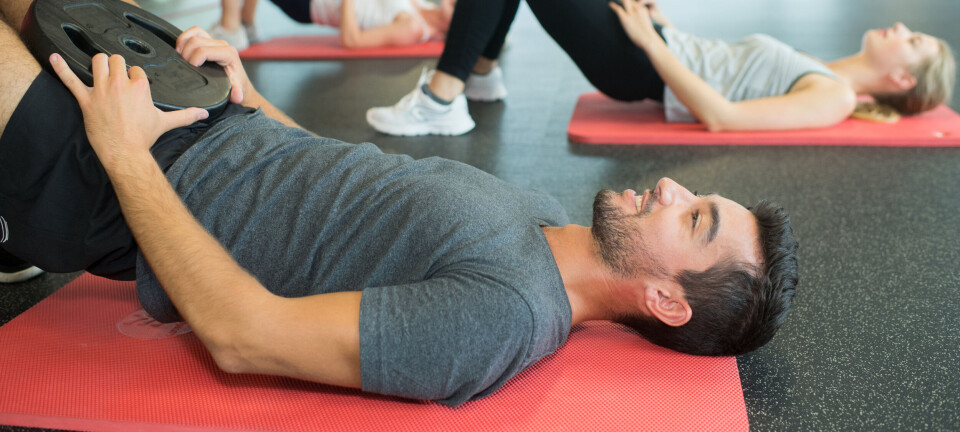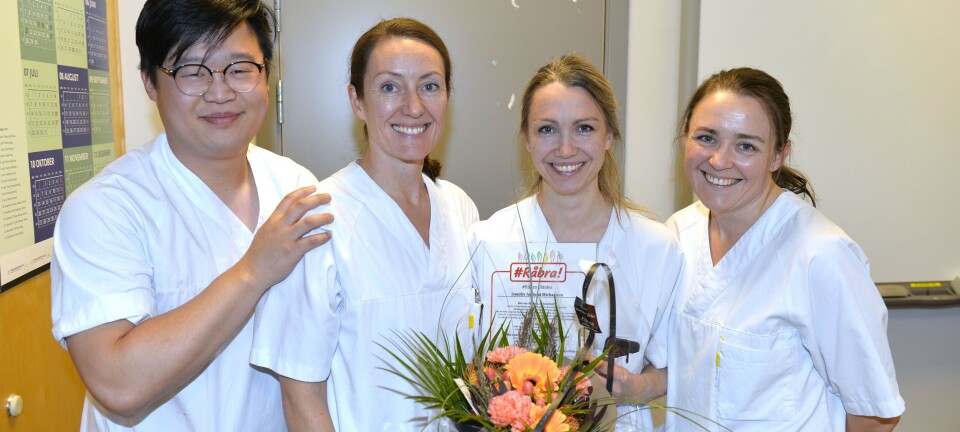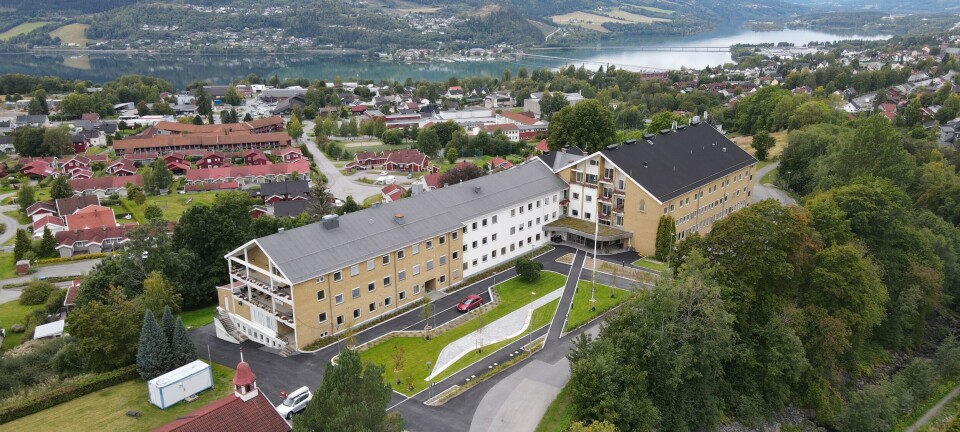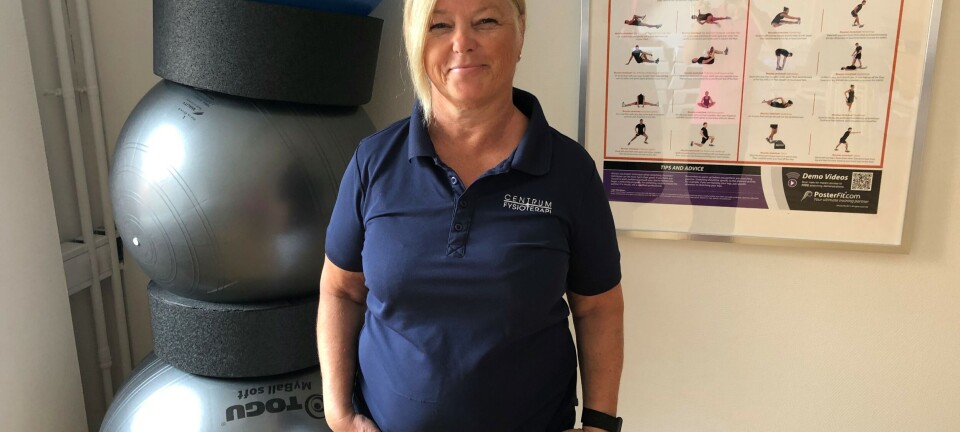Physiotherapy and music therapy for a girl with Rett Syndrome, a dual treatment approach
Kasusrapport, Fysioterapeuten nr. 2/2006
Pdf av artikkelen her
Deler av denne artikkelen er tidligere publisert i Nordic Journal of Music Therapy. Originalartikkelen kan leses på nettstedet til tidskriftet www.njmt.no
Artikkelen ble mottatt av Fysioterpeuten 1.11.2005 og akseptert for publisering 6.12.2005.
n
Sammendrag
Fysioterapi og musikkterapi som en kombinert tilnærming for personer med Rett syndrom (RS) ble satt i gang som følge av lidelsens komplekse og utfordrende manifestasjoner. RS er en genetisk lidelse som i de fleste tilfeller rammer kvinner. Både fysisk aktivitet og fysioterapi er anbefalt som tiltak for pasienter med RS, men ofte blir behandlingsformen mislikt av pasientene selv. Musikkterapi er kjent som et effektivt og egnet tiltak og er svært godt likt av pasientgruppen. For å kunne imøtekomme RS pasientenes fysiske og medisinske behov, utvikle deres samarbeidsevne og anerkjenne deres emosjonelle og kommunikative behov, ble en kombinert behandlingstilnærming av fysioterapi og musikkterapi, prøvd ut. Behandlingen har et bredt terapeutisk perspektiv og medfører at begge terapeutene oppnår de terapeutiske målene i behandlingssituasjonen, uten at pasienten motstiller seg behandling. Samtidig viser behandlingen å ha god effekt på barnets kommunikasjonsevner. Denne kasusrapporten gir et innblikk i den kombinerte behandlingen i et eksempel med en ni år gammel jente med RS. Hovedfokus er på de fysiske og motoriske aspektene ved behandlingsforløpet. Vi foreslår at lignende intervensjoner også kan introduseres i tilnærmingen til personer med andre alvorlige funksjonshemminger. Nøkkelord: fysioterapi, musikkterapi, Rett syndrom, kombinert behandling.
n
Abstract
Physiotherapy and music therapy (dual intervention approach) for individuals with Rett Syndrome (RS) was initiated as a result of the complex and challenging features which characterizes this disorder. RS is a genetic disorder effecting mainly females. Due to its debilitating characteristics, physical activity and physiotherapy is highly recommended however often disliked by these patients. Music therapy has long been suggested as a preferred therapy intervention, highly effective and greatly loved by the patients.
In order to address the patients with RSs physical and medical needs and at the same time enhance their cooperation and take into consideration their emotional and communicative needs, a dual treatment program of music and physiotherapy was introduced. This approach augments a broad therapeutic perspective and thus establishes a better quality treatment. This intervention approach has enabled both therapists to raise physical requirements of the patient without rejection of the therapy program. At the same time the dual approach proved effective in improving the childs communication skills. This article presents a dual physical and musical treatment approach with the case example of a 9 year old girl with RS. The main focus is on the physical and motor skill aspects of the treatment. The authors suggest similar approaches might be introduced to other individuals with severe disabilities. Key words: Physiotherapy, Music Therapy, Rett Syndrome, Dual intervention.
Introduction
Rett Syndrome (RS) is a neurological disorder diagnosed predominantly in girls (1). It is characterized by the deterioration of behavioural, social, cognitive, communicative and functional skills to a profound level, after a seemingly normal first six to 18 months of life (2). Its etiology is derived from impairment in an X-linked gene (3, 4). There is no known cure to RS, and care provided by conventional treatments (music-, physical-, occupational-, speech- and hydrotherapy) seem to relieve and improve the patients symptoms (1). The incidence of RS is between 1:10.000 (5) and 3.8:10.000 (6) in female births, and it is considered as the second most common cause for severe mental retardation in females after Down syndrome (5).
The development of Rett Syndrome is
characterized by four stages:
Stage I - Onset
This stage appears between the ages six months to one year. This stage is usually overlooked as there are no evident neurological symptoms. The infant may show less eye contact and have reduced interest in toys. There may be delay in gross motor milestone, but at times the child may show an increase in refined hand use (i.e. handling a telephone dial, shifting pages of a book). This stage may take a few weeks and up to a few months.
Stage II - Destructive
This stage appears between the ages one to four years. This stage can have a gradual or rapid onset as purposeful hand skills and spoken language are lost. Stereotyped hand movements begin to emerge and may include: hand-wringing, hand-clapping, hand- washing and hand-to-mouth movements. Breathing irregularities may be noticed and may include episodes of breath holding and hyperventilation.
Some girls appear autistic-like with loss of social interaction and communication (behaviours which situates those children under the umbrella term of PDD on the DSM-IV). General irritation and sleep irregularities are typical. Slowing of head growth can be noticed from three months to four years when the girls head circumference falls below the percentile chart.
Stage III - Plateau
This stage is usually detected from around the age of two and above and sometimes lasts throughout the individuals life. This is a more balanced period. Clear signs of RS are apparent at this stage and may include: reduced hand function, apraxia, ataxic gait, difficulty maintaining equilibrium, scoliosis, gravitational insecurity and seizures. However, improvement is seen in behaviour with less irritability and crying and less autistic-like features. The girls show more interest in their surroundings especially in people. Alertness, attention span and communication skills might improve.
Stage IV Late Motor Deterioration
If this stage begins, it starts around the age of ten and is characterized by reduced mobility. Some girls stop walking (stage IV A) while others may have never walked (stage IV B). There is no decline in cognition, communication or hand skills. Repetitive hand movement may decrease. Scoliosis is a prominent feature in about 85 percent of children with RS (3). Rigidity (stiffness) and dystonia are common characteristics (7).
Experts in the field of RS now believe that this fourth stage might be avoided under intensive appropriate therapeutic care (8).
Intervention for individuals with RS
The treatment of children with RS is essential in order to accommodate them with maximum level of functioning and to provide them and their families the best possible quality of life. Physical therapy and music therapy are two important forms of intervention for girls with RS.
Physical Therapy in the Treatment of RS
Since life expectancy in RS is evaluated at 49-50 years of age (9) and due to the vast physical challenges experienced by children with this disorder, treatment, especially physiotherapy treatment, is essential. The secondary deterioration typical of adolescents with this disorder compels physiotherapy as one of the most important treatments for individuals with RS and is applied to almost 80 percent of girls with this disorder (10).
Despite the debilitating characteristics of RS many physical intervention programs have been found to yield positive results for this population:
Individuals with RS are less mobile than their peers. This leads to a sedentary life style, reduced cardiovascular abilities and low functional levels. Improvement of functional abilities and cardio-vascular capacities were found to be the result of a daily treadmill training program introduced to four children with RS (11).
Scoliosis is a severe problem for children with RS due to its frequency (up to 85 percent) and severity (an average increase of 14 degrees a year) (2). The reduction of scoliosis curve was found possible through an intensive intervention program with one child with RS (see picture 3). This intervention program was implemented through the use of various positioning postures of the child (12).
Additional complications of RS might be: limb deformity, fear of movement, improving hand function or loss of walking ability. Such complications might be reduced and even avoided through the use of hydrotherapy (13).
Many children with RS show neurological and sensorial difficulties such as: poor limb coordination during function, postural and equilibrium difficulties, diminished hand functioning, apraxia, ataxia, and other sensory and perceptual problems. Such complex issues might be improved through the use of Snoezelen (see picture 2), also known as the controlled multi-sensory environment (14, 15).
All those characteristics are commonly introduced by individuals with RS and are all apparent with the girl who will be described in this case example. The intervention was planned to address some of those issues.
Music Therapy in the Treatment of RS
Music Therapy was recommended by Dr. Andreas Rett as early as 1982 as means of treating individuals with RS (16). Its potential to promote and to motivate their desire to interact and to communicate with their surroundings as well as in developing their cognitive, affective, sensory-motor and physical abilities has been revealed and reported by many (17-34).
Since girls with RS express and communicate their emotions and feelings through facial, bodily expressions and vocalization, the music therapist can create music that reflects and supports these expressions. By doing so the therapist creates a safe and a special enabling environment, consequently helping to broaden and to increase the girls «circles of communication». Through these musical creations the music therapist can become familiarized with the way the child expresses her feelings, and with this knowledge the music therapist can build the base for a close intimate interaction (see picture 1).
The Dual Approach Physical and Music Therapy
We have chosen to work in a dual approach with girls with RS who are in Stage IV as we found it beneficial for the girls, for the physiotherapist and for the music therapist. The dual treatment approach was implemented for several years and had positive results. The treatment plan was conceived in accordance to the childs physical and emotional state and was planned to answer the childs therapeutic needs in a comprehensive way. The initial plan was very structured (see table 1), but the actual implementation was flexible according to the childs state during each session.
The reasons which brought the authors to unify the physical and musical treatments were directly connected to the child condition and to the interaction with both therapeutic milieus.
Talia a Case example
Talia is a nine year old girl with RS. She developed normally until the age one and a half years. She then stopped maintaining some acquired milestones that she previously had engaged in. Other diagnosis, secondary to RS include: mild scoliosis (stable at present) with no orthopedic support, and epileptic seizures (about two per week), despite her large dosage of anti-convulsing medication.
Talia walks with considerable support, sits with no support for limited periods of time (a few minutes). In order for her to be able to sit for long periods of time (as is expected during therapy sessions), external support is needed. When seated on the mattress she frequently falls from sitting to laying position without using protective extension. When this occurs, she cannot return independently to a sitting position and needs the help from others (stabilizing her pelvis).
Communicatively she did not use any alternative communication system before the beginning of the dual treatment and did not even show minimal choice preference.
Hand usage is extremely limited, and Talia is totally dependent on caregivers support throughout all activities of daily living including feeding and self care.
Emotionally she is very capable and expresses her emotions through laughs, cries, body movements, teeth grinding and facial expressions.
Physical Therapists Point of View
Along the life span of females with RSs there are times where their ability to move independently decreases and their ability to maintain posture and stability (even while sitting) is deteriorating. These periods of deterioration are frequently temporary and the child returns to her former abilities. As a result, during these periods, they need to receive an increased dosage of movement and physiotherapy (35). Since physiotherapy is suggested as an important treatment against scoliosis (36-38) and since transfer abilities are usually the first functional capabilities to be lost in RS (39), physiotherapy is of extreme importance and even a vital treatment for individuals with RS.
In spite of its importance, physiotherapy can be unpleasant, and even penetrating. These facts may induce unpleasant feelings, which the girls are incapable of expressing. Individuals with RS function according to their emotional state, and when they dislike physical treatment (as in the case example), they might react by falling asleep and even by evoking a seizure. In this special case example (described below) we found it necessary to intervene by providing a positive milieu for treatment and by helping to increase her motivation.
Before implementing the dual intervention Talias physical therapy program was implemented twice a week for half an hour sessions. During that time, Talia showed no will to cooperate, her physical performance was below her known abilities and she was mostly unhappy. In order to avoid total rejection by her, physical demands were lowered, and there was little hope for a change in her attitude or the intervention outcome. It was hypothesized that the use of music will help Talia to intensify her motivation and participation, thus achieving higher level of functional demands during physical therapy sessions.
Music therapists point of view
Before the introduction of the dual intervention Talia received music therapy twice a week for half an hour sessions. Despite her obvious affection to music, the music therapist found it very difficult to provide music therapy while Talia was constantly occupied with maintaining her body positioning, thus not able to freely participate in any musical activity. It was clear that in order for Talia to attain concentration, communication, emotional expressions and to reduce hand stereotypic movement, she needed physical support.
Due to these problems, the need for joint treatment was aroused. It was hypothesized that through the dual treatment the music therapy will create an atmosphere that will enable the space necessary for the physical therapeutic process to develop.
The joint treatment
These conflicts paired with professional needs and the girls preferences, made it necessary to combine the physical therapist who presents the child with physical demands and the music therapist, who prepares, reflects, interprets, contains and structures the sessions. The combination of music and physical therapy raised Talias physical performance while at the same time converted the treatment from being difficult and disliked by her, to a more complete and positive experience partially controlled by Talia.
The musical content was functioning as a vessel which provided freedom for expression for different emotions. Whilst there was a space for expression, the music created a clear structure for the treatment. By repeating the same structure every session, the child could anticipate every phase of the treatment. This created a sense of trust and security that helped Talia to build a positive feeling of suspense towards the next phase of the treatment.
Another important aspect was that the music created by the music therapist helped to motivate Talia. In such a positive milieu the physiotherapist was able to elevate therapeutic demands and to achieve maximal results without any resistance or any aversive behaviour by Talia.
Targets of treatment for Talia
The targets of physiotherapy intervention:
- To establish rapport and a positive atmosphere towards the intervention: This goal was established through gradual verbally preparing Talia before each session.
- Maintaining walking abilities, improving balance and equilibrium reactions: These goals were established by walking with Talia to and from the physical therapy room and by challenging Talia to maintain erect postures while walking and within the session.
- Proprioceptive preparation towards movement while improving body scheme: These goals were established by giving sensory proprioceptive stimuli to Talias body and to different limbs.
- Maintaining spinal range of motion and centering Talias midline perception: These goals were achieved through movement opposite to the childs natural scoliotic curve, and are in accordance with «over correction» therapeutic intervention for scoliosis developed by Susan Hanks (40) and prior work by the first author (12). Rolling on a mattress was planned to achieve similar effects.
- Acceptance of movement by an external facilitator (while practicing balance reaction and protective extension): Fear of motion, and as a consequence, the rejection to external manipulation, is common to many individuals with RS. A play like exercise on the green physiotherapy ball enabled us to overcome such resistance.
- Improving hand usage: This is achieved by massaging the childs hands and by supporting Talias body while she was introduced with manual demands (playing the guitar, beating the ocean drum and communicating).
- Addressing educational goals: The physical therapist working in an educational setting needs to support the achievement of educational goals of each student. By supporting the child body the physical therapist helped to promote educational goals such as: communication skills, attention span, decrease stereotypical hand movements and enhancement of the childs vocalization.
Targets of the Music Therapy intervention
- To provide a consistent and relaxed treatment setting.
- To provide a place for self control.
- To develop a sense of confidence and trust through the musical relationship.
- To provide a supportive environment where Talia could express her emotions such as: frustration and fear of movement.
-To enhance and to develop Talias awareness of herself and of her surroundings.
- To enhance Talias communication skills such as: non-verbal expressions, vocalization or verbal ability.
- To increase Talias attention span.
- To reduce hand stereotypical movements and to increase hand functioning.
These general goals were implemented into different phases of the dual intervention. The basic plan for all treatment sessions with Talia is shown in table 1. The treatment session can also be viewed step by step on a video recording displayed on the Nordic Journal of Music Therapy website: http://www.njmt.no
Treatment Outcome
The dual treatment, described above, enabled us to shorten treatment time for Talia (two ¾ hour treatments per week instead of four ½ hour treatments). At the same time, the new treatment regime enabled therapy possibilities that were unavailable during past therapeutic arrangements.
The physical level of difficulty in the treatments was raised and became more complex than the individual treatments that preceded this approach (for instance asking Talia to use her hands without external support during music therapy sessions became possible during this intervention; or working with Talia on protective extension was done during individual PT sessions only slowly and from a seating position on a mattress, but during this intervention it was performed during swift movement changes on a physiotherapy ball).
Talias communication choice making abilities advanced dramatically, from an inability to choose between objects (Honey and lemon juice), to choosing from picture symbols (Song names). These skills were immediately transferred to Talias classroom and home. The development of such new skills for a disabled child has a dramatic effect on her independence, self esteem, self-confidence and quality of life. The outcome of this treatment correlated with the rational which initiated the dual intervention of music and physical therapy.
Conclusion
Individuals with RS are usually extremely disabled. Most are slow to react to external stimuli and dread movement by external facilitators. When physical therapy intervention is applied without atonement to the childs emotional state she might react with lack of cooperation and even obvious rejection. Such reactions can be avoided by introducing additional motivational factors such as: video films, food, animals and the assistance of the childs family members. While all such additions might help, music is surly the most motivational of all.
The introduction of music, which has been highly recommended for this population, has been found again in this case, critical in achieving cooperation and enjoyment from the child. Thus, on occasions where the physical progress of a therapeutic intervention comes to a halt, the introduction of dual intervention such as the one presented in this article might be considered.
We believe that the treatment described in this article can open up a window of opportunity to advance treatment possibilities for children with RS exhibiting multiple disabilities. We also believe that this treatment approach can be implemented with other children exhibiting a combination of movement, sensory, speech and motivation difficulties. By implementing this approach the results will reward the child and the therapists as one. This approach shows that even in a severe neurological disabling disorder, such as RS, there is always a possibility of excelling treatments and achieving additional functioning and less disability.
Acknowledgements:
Special thanks to Talia, her family and to the parents who gave permission use her story in this article. Thanks to Beit Issie Shapiro center where this treatment took place and to the NJMT who gave us permission to reprint some of the original article material.
n
References
1. Hunter K. The RS Handbook. Washington DC: International RS Association: 1999.
2. Hagberg B. RS: Clinical and Biological Aspects. London: Mac Keith press; 1993.
3. Amir RE, Van den Veyver IB, Wan M, Tran CQ, Francke U, Zoghbi HY. RS is caused by mutation in X-linked MECP2, encoding methyl-CpG-binding protein 2. Nature Genetics 1999; 23:185-7.
4. Amir RE, Van Den Veyver IB, Schultz R, Malicki DM, Tran CQ, Dahle EJ, Philippi A, Timer L, Percy AK, Motil KJ, Lichtarge O, Smith EO, Glaze DG, Zoghbi HY. Influence of Mutation Type and X Chromosome Inactivation on RS Phenotypes. Ann Neurol 2000; 47:670-9.
5. Ellaway C, Christodoulou J. RS: Clinical Characteristics and Recent Genetic Advances. Disabil Rehabil 2001; 23: 98-106.
6. Fombonne E, Simmons H, Ford T, Meltzer H, Goodman R. Prevalence of Pervasive Developmental Disorders in the British Nationwide Survey of Child Mental Health. Int Rev Psychiatry 2003; 15:158-65.
7. International RS Association (IRSA) (1997). Internet site: www.RettSyndrome.org/what is
8. Ben-Zeev B. Introduction to RS and new findings. A lecture presented at a national conference on RS, Sheba Hospital, Ramat-Gan, Israel, 2005.
9. Percy AK. International Research Review. Paper presented at the IRSA 12th Annual
conference. Boston, MA (24-27 May) tape 622-15, 1996.
10. Leonard H, Fyfe S, Leonard S, Msall M. Functional Status, Medical Impairments, and Rehabilitation Resources in 84 Females with RS: a Snapshot Across the World from the Parental Perspective. Disabil Rehabili 2001; 23:107-17.
11. Lotan M, Isakov E, Merrick J. Improving functional skills and physical fitness in children with RS. J Intellect Disabil Res 2004; 48:730-5.
12. Lotan M, Merrick J, Carmeli E. Scoliosis Management in RS A Case Study. Scientific World Journal 2005; 5:264-73.
13. Lotan M, Yoshi Y, Hadar-Frumer M. Aquatic Rehabilitation for Individuals with Rett Syndrome. (Hebrew). The Journal of the Israeli Physiotherapy Society 2002; 4:13-23.
14. Lotan M, Merrick J. RS Management with Snoezelen or controlled multi-sensory environment. A review. Int J Adolesc Med Health 2004; 16:5-12.
15. Lotan M, Shapiro M Management of young children with Rett disorder in the controlled multi-sensory (Snoezelen) environment. Brain Dev 2005; 27(Suppl.) 1:88-94.
16. Rett A. Grundlagen der Musiktherapie und Music-Psychologie. Herausgeber G. Harrer. Vol. 2. Stuttgart: Neubearbeitete Auflage; 1982.
17. Allan I. RS: A View on Care and Management. Scotland, UK: The National RS Association; 1991.
18. Coleman KA. Music Therapy in RS. Educational and Therapeutic Intervention in RS. Clinton, MD: IRSA; 1987.
19. Elephant C. Speechless yet Communicative: Revealing the Person behind the Disability of RS through Clinical Research on Songs in Music Therapy. In: Aldridge D, Di Franco G, Ruud E, Wigram T (eds). Music Therapy in Europe. Rome: ISMEZ; 2001.
20. Elephant C. Enhancing Communication in Girls with RS through Songs in Music Therapy. Ph.D. thesis: Aalborg University; 2002.
21. Elephant C. The Use of Single Case designs in Testing a Specific Hypothesis. In: Aldridge D (Ed). Case Study Designs in Music Therapy. London: Jessica Kingsley; 2004.
22. Elephant C, Lotan M. Rett syndrome: Dual intervention music and physical therapy. Nordic Journal of music therapy 2004; 13:172-82.
23. Hadsell NA, Coleman KA. RS: A Challenge for Music Therapists. Music Therapy Perspectives 1988; 5:52- 6.
24. Hill SA. The Relevance and Value of Music Therapy for Children with RS. British Journal of Special Education 1997; 24:124-8.
25. Kerr A. Communication in RS. London: RS Association UK; 1992.
26. Lindberg B. Understanding RS. New York: Hogrefe & Huber; 1991.
27. Merker B, Bergstrom-Isacsson M, Witt Engerstrom I. Music and the Rett Disorder: The Swedish Rett Center Survey. Nordic Journal of Music Therapy 2001; 10:42-53.
28. Merker B, Wallin NL. Musical Responsiveness in the Rett Disorder. In: Kerr A, Witt Engerstrom I (Eds). The Rett Disorder and the Developing Brain. Oxford: Oxford University Press; 2001.
29. Takehisa K, Takehisa-Silvestri G. Intermediate Results of Music Therapy in Interdisciplinary Work with RS in Institut Haus der Barmherzigkeit, Vienna. Institut Haus der Barmherzigkeit, Vienna, Austria, (n.d.).
30. Wesecky A. Music Therapy for Children with RS. Am J of Med Genet 1986; 24: 253-7.
31. Wigram T. Assessment and Treatment of a Girl with RS. In: Bruscia K (Ed). Case studies in Music Therapy. N.H. USA: Barcelona Publication; 1991.
32. Wigram T. A Model of Assessment and Differential Diagnosis of Handicap in Children through the Medium of Music Therapy. In: Wigram T, Saperston B and West R (Eds), The Art & Science of Music Therapy: A handbook. Chur, Switzerland: Harwood Academic Publishers GmbH; 1995.
33. Wigram T. Vibroacoustic Therapy in the Treatment of RS. In: Wigram T, Dileo C (Eds.). Music Vibration and Health. Cherry Hill, N.J.: Jeffrey Books; 1997.
34. WigramT, Cass H. Music Therapy within the Assessment Process for a Therapy Clinic for People with RS. Paper presented at the RS World Conference in Sweden; 1996.
35. Beuchel K. Physical Therapy and Gross Motor Skills in RS. A Handout received at the IRSA annual conference: Washington, DC; May 2001.
36. Rossin LK. Effectiveness of Therapeutic and Surgical Intervention in the Treatment of Scoliosis in RS. University of Duquesne; 1997.
37. McClure MK, Battaglia C, McClure RJ. The Relationship of Cumulative Motor Asymmetries to Scoliosis in RS. Am J Occup Ther 1998; 52:488-93.
38. Weeks L. RS. A lecture presented to parents at Sydney, Australia; 1997.
39. Hanks SB. Motor Disabilities in the RS and Physical Therapy Strategies. Brain Dev 1990; 12:157-61.
40. Hanks SB. Physical therapy strategies. Lecture presented at the IRSA 12th Annual Conference, Boston, MA.,(24-27 May), tape 622-08, 1996.






















